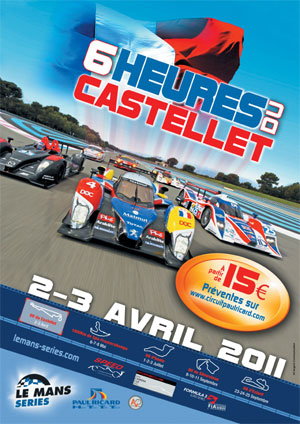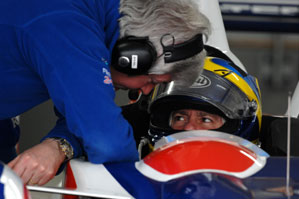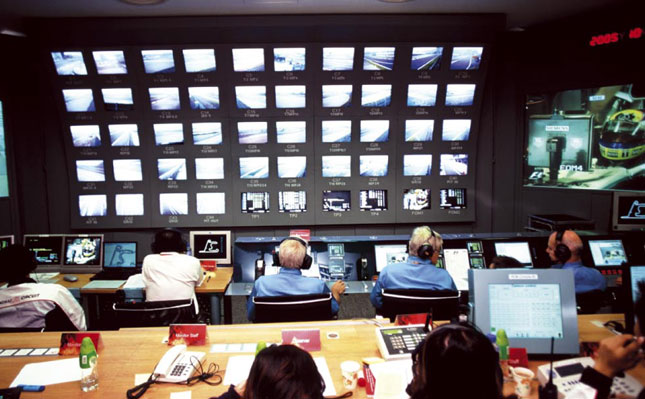 Once
more into the breach
Once
more into the breach
It
has been a frenetic month for the team
at RML AD Group. The arrival of the
new chassis came later than expected,
and several gallons of midnight oil
were burned in order to ensure
that the new Honda Performance Development
HPD ARX-01d would be ready for the
first event of the year.
Just
over a fortnight ago the car made its
debut appearance on track for the official
pre-season test, also at the Paul Ricard
circuit near Marseilles. Up until
that point the car had never even turned
a wheel, so it was with a blank sheet
of paper that Team Manager Phil Barker
and his mechanics arrived at Le Castellet
on March 9th to prepare for the two
days of testing. In that light, the
results were impressive. The car never
missed a beat, and all three drivers
were able to enjoy extended sessions
in the cockpit - vital experience ahead
of the start of the racing season (Full
report here).
Struggling for Air
If
any concerns did arise out of that
test, they were shared by several
other competitors in the LMP2 class,
although few can have encountered the
depths of frustration experienced by
Mike Newton, Thomas Erdos and Ben Collins.
While there's little doubt that the
ARX chassis is one of the best in the
business, the power being released
from the engine - or should that be,
strangled within it - left
the #36 RML car gasping for air along
the main straight.
The
speed trap figures merely confirmed
what the drivers themselves reported
- the top-end performance was way short
of expectations, and RML AD Group's
LMP2 contender was officially the slowest
car in a straight line. Outgunned by
even the tail-end GTE runners, and
comprehensively blown away by the best
of the Formula Le Mans cars, a decent
lap time was only made possible by
the car's remarkable ability through
the tighter twists and turns and the
skill of her drivers.

Since
then the first round of the American
Le Mans Series has taken place at Sebring,
in America. Governed largely by the
same rules and regulations, a similar
picture emerged there, with LMP2 cars
unable to compete against the LMPC
(Formula Le Mans) or quicker GT cars.
Reporting on the event, Dailysportscar's
Graham Goodwin stated: "LMP2 needs
some attention – fast! All
but one of the P2 runners qualified
behind an extraordinary LMPC qualifying
battle. The alarm bells which
rang in LMS testing [at Paul Ricard]
should surely be a clarion call to
action for the ACO by now – a
reversal of a restrictor relaxation
for the FLM Orecas simply wasn’t
enough." In the twelve-hour race
itself, the LMP2 winner claimed 20th
overall, while first to take the chequered
flag in LMPC finished ninth, and
the leading GT car crossed the line
tenth.
 The
result at Sebring, combined with the
times set at Paul Ricard for the official
test, and supported by the reports
arising from independent testing elsewhere
by LMP2 teams, would all tend to suggest
that the regulations governing the
relative speeds of the five classes
in the Le Mans Series need a radical
overhaul, and urgently.
The
result at Sebring, combined with the
times set at Paul Ricard for the official
test, and supported by the reports
arising from independent testing elsewhere
by LMP2 teams, would all tend to suggest
that the regulations governing the
relative speeds of the five classes
in the Le Mans Series need a radical
overhaul, and urgently.
The
ACO's intention is that each class
should be distinctly and uniquely balanced,
with LMP1 fastest overall, followed
by LMP2, then FLM (LMPC), and with
the GTE-Pro and GTE-Am bringing up
the rear. There should be a narrow
overlap between the slowest in one
class, and the fastest in the next.
Using the tools at their disposal,
including the overall weight of each
car and the power output from the engine
(controlled by "restrictors" that
determine inlet airflow) the ACO can
govern the ultimate pace a car should
be able to achieve. There's no denying
it's a sorcerer's art, but in this
instance, the results demonstrate that
the magic has comprehensively failed.
While the LMP1 cars are undeniably
quickest, the FLM cars have a clear
edge over LMP2, and most of the GT
cars are faster too.

It
is believed that official representations
have been made on behalf of the LMP2
teams by several of the engine and
chassis manufacturers involved, and
some of the teams themselves have also
been in discussion with the ACO. It
can only be hoped that swift action
follows, and the correct status
quo is established before the
2011 season develops much further.
If not, then LMP2 drivers face the
task of being unable to pass the "lower
classes" on the straight, and being
forced into late-braking derring-do
into the corners and overtaking round
the bends - a recipe for frayed nerves
and potential disaster.
Despite
this, a strong entry for LMP2 has been
posted for the Paul Ricard Six
Heures du Castellet, including
several names and faces that will be
familiar from 2010.
The
Class of 2011
The
full entry list for LMP2 and Formula
Le Mans is reproduced below. If one
is available, clicking on the thumbnail
will reveal an enlargement.
M = Michelin Tyres, D = Dunlop Tyres
Without
exception it's "all change" in
LMP2 this year. Fundamental revisions
in the regulations (which we outlined
here at the end
of last season) have meant that last
year's LMP2 cars are no longer
eligible to race in the same class
again - at least, not without substantial
modifications.
As
a result the ex-RML, now RLR
Motorsport MG Lola EX265 (right), which
joined the Le Mans Series in 2010 from
Hungary onwards, hides a BMW-derived
Judd V8 beneath the familiar bodywork.
The Greaves Motorsport (formerly Team
Bruichladdich) Zytek has replaced the
race-designed engine for a production-based
Nissan. The Strakka Racing HPD chassis,
inherently the same as the one campaigned
so impressively in 2010, has swapped
the naturally-aspirated V8 for a twin-turbo
V6 - an engine that can trace its ancestry,
just one generation removed, from the
same Honda V6 that powers the company's
top-end Accord. It is, of course, now
the same specification as the HPD being
run by defending champions RML AD Group.
 Elsewhere
in the class we see these same engines,
or very similar ones built around standard
road-car blocks, powering some new
racecars. The Pecon Racing Lola is
perhaps the most distinctive, with
its new-for-2011 regulation "shark's
fin" standing proud along its spine.
One of the latest breed of "cost-capped"
LMP2 cars, this Lola is (some fear)
the shape of things to come. Not as
pretty as the previous coupé, the car
has been built within a tight budget
and meets the new rules to the letter.
As a result it is gifted a 20 kilogram
advantage over the older, updated cars,
and has a larger restrictor, so should
have more power and pace.
Elsewhere
in the class we see these same engines,
or very similar ones built around standard
road-car blocks, powering some new
racecars. The Pecon Racing Lola is
perhaps the most distinctive, with
its new-for-2011 regulation "shark's
fin" standing proud along its spine.
One of the latest breed of "cost-capped"
LMP2 cars, this Lola is (some fear)
the shape of things to come. Not as
pretty as the previous coupé, the car
has been built within a tight budget
and meets the new rules to the letter.
As a result it is gifted a 20 kilogram
advantage over the older, updated cars,
and has a larger restrictor, so should
have more power and pace.
The
Oreca 03, as championed by TDS Racing
(pictured right, in an all-black
pre-livery test) and Race Performance, is another
of the "cost-capped" cars,
but somehow this 2011 pace-setter seems
to have escaped the imposition of a
dorsal fin. The explanation from Oreca
has been that the chassis was designed
before the 2011 regulations were confirmed,
but that it is still economically
capable of building the car within
the constraints of the "cost capped"
requirements. However, they claim,
the aerodynamics of the chassis might
be adversely effected by the addition
of a fin, and the added expense
of testing whether this was the case
would contribute substantially to the
final cost of the car. As a result,
the price tag would rise, and thus
fail to meet the ACO's stipulated cost-cap
ceiling.
The
French manufacturer appears to have
won its case, and with it the 20 kilo
dispensation and a set of juicy restrictors.
At the official Paul Ricard test,
and again at Sebring, the Oreca 03
Nissan proved to be the class act in
LMP2, comfortably quickest in the category
but, as retirement proved in America,
not necessarily the most reliable.
Once
again we list the Formula Le Mans cars
in close proximity to the LMP2 entrants,
and with good reason. Last year the
best drivers in FLM, such as Warren
Hughes, regularly "mixed
it" with the LMP2 mid-field. This year,
if the regulations aren't adjusted,
they'll eclipse most of them, and end
up challenging the leaders. The one
to watch is the Neil Garner Racing
#92, and especially when young Phil
Keen is in the cockpit. The all-British
squad should be a contender for the
FLM class honours, and perhaps better
still.
LMP1
There
are just six LMP1 entries for the opening
round of the Le Mans Series this year,
with both Peugeot and Audi absent.
They are scheduled to appear for Round
2 at Spa, which will also double as
Round 2 of the Intercontinental Le
Mans Cup. Audi will, it is hoped,
debut the new R18 (complete with dorsal
fin) in Belgium and, after post-Sebring
testing, Peugeot may have every reason
to fear the arrival of the new car.
It proved very quick indeed, and this
at a time when Peugeot's updated 908
is having aerodynamic problems of its
own. Several accidents in recent weeks,
including a very serious tumble at
Paul Ricard (during a private test)
suggest that the car is not as stable
as the drivers might like.
 With
the big guns absent, a solo AMR-ONE
from Aston Martin Racing will challenge
a pair of Rebellion Lola Coupés
(#12 & 13), a Pescarolo
Judd (#16),
the Guess Racing Europe Lola Coupé,
and the Quifel ASM Zytek 09C. The AMR-ONE
(left)
is an exciting new arrival, of course,
and represents Aston's first own-built
challenger for an outright win at Le
Mans for many years. The British marque
hasn't won the 24 Hours since 1959,
but there are high hopes for the new
chassis. Unlike Peugeot and Audi, AMR
has opted for petrol-power and an open-topped
car. The Paul Ricard 6 Hour will be
its debut, and the world will be watching.
With
the big guns absent, a solo AMR-ONE
from Aston Martin Racing will challenge
a pair of Rebellion Lola Coupés
(#12 & 13), a Pescarolo
Judd (#16),
the Guess Racing Europe Lola Coupé,
and the Quifel ASM Zytek 09C. The AMR-ONE
(left)
is an exciting new arrival, of course,
and represents Aston's first own-built
challenger for an outright win at Le
Mans for many years. The British marque
hasn't won the 24 Hours since 1959,
but there are high hopes for the new
chassis. Unlike Peugeot and Audi, AMR
has opted for petrol-power and an open-topped
car. The Paul Ricard 6 Hour will be
its debut, and the world will be watching.
The
presence of the Toyota Motorsports
TMG logo on the Rebellion Lolas should
not go unremarked, and is another sign
of the growing interest in endurance
racing from the major manufacturers.
Added to the presence of Nissan and
Honda in LMP2, and Peugeot, Audi and
Aston in LMP1, this is perhaps the
highest concentration of "manufacturer"
involvement in sportscar racing for
many years.
The
final mention in dispatches goes to Quifel
ASM (below right, #20 ). Having
invested in the Zytek chassis, similar
to Greaves Motorsport, the Portuguese
squad faced the same choice at the end
of last season - revise the car, fit
a new engine, and stay in LMP2, or retain
more of the car, carry out some less
costly upgrades, and challenge in LMP1.
They chose the latter. After many seasons
as front-runners in LMP2, it will be
interesting to see how the Pro-Am line-up
of Pla and Amaral fare in the harsh
world of the upper echelon of sports
prototype racing. The duo's first showing,
in the pre-season Ricard test, suggests
that the pace is there.
GTE
Ten
GTE-Pro and six GTE-Am entries complete
a total grid of 36 for the first Le
Mans Series race of the year - a number
likely to grow as the season progresses.
There is no GT1 this year - not in
LMS racing anyway - and instead we
have two GTE classes, almost indistinguishable
to the naked eye. The only give-away
is the colour of the number panels:
 |
 |
 |
 |
 |
LMP1 |
LMP2 |
FLM |
GTE-Pro |
GTE-Am |
Beneath
the bodywork there are a number of
significant differences. Firstly, the
GTE-Am cars can employ no more than
one professional driver
in the line-up (just as LMP2 must have
at least one amateur driver) while
GTE-Pro cars can be shared by an all-professional
squad. There are also technical and
mechanical differences, with GTE-Am
cars also having to be at least a year
old, although certain dispensations
have meant that some GTE-Am cars have
the potential to be quicker than their
GTE-Pro counterparts. As suggested
before, performance balancing is a
challenging art! Whatever the means,
the consequences are clear - the faster
GT cars will be as quick. if not quicker,
than many of the prototypes.
Support Races
There
are three support series to this year's
LMS races. The F3 Euroseries
is a single seater, open-wheel championship
seen as one of the feeder channels
for young drivers aspiring towards
a future in Formula 1. The Porsche
Matmut Carrera Cup is the French equivalent
of the popular UK Carrera Cup, and
one step down from the international
Porsche Supercup. It is a one-make
series for Porsche 911 type racecars.
 The
Speed EuroSeries is a new addition
to the international calendar, having
previously been a largely British-based
championship, although with close links
to the VdeV series on the continent.
The championship is seen as a springboard
for drivers and teams hoping to move
through to a full-blown future in sportscar
racing, and features "mini-prototypes"
that are often as quick as their bigger
cousins in the LMS. With a large grid
and some familiar manufacturers, teams
and even drivers, this promises to
be an exciting and worthy support spectacle
to the main event . . . and makes a
pleasant change from Transit Vans!
The
Speed EuroSeries is a new addition
to the international calendar, having
previously been a largely British-based
championship, although with close links
to the VdeV series on the continent.
The championship is seen as a springboard
for drivers and teams hoping to move
through to a full-blown future in sportscar
racing, and features "mini-prototypes"
that are often as quick as their bigger
cousins in the LMS. With a large grid
and some familiar manufacturers, teams
and even drivers, this promises to
be an exciting and worthy support spectacle
to the main event . . . and makes a
pleasant change from Transit Vans!
A
History of Paul Ricard HTTT
In
our preview to last year's race at
Le Castellet
we compiled a history of the track,
and a background to the man, the drink,
and the culture. If you'd like to explore
that aspect of Paul Ricard, please
click this link:
Paul
Ricard - A Brief History

A
lap of Paul Ricard
The
circuit at Paul Ricard is one of the
finest in motorsport, and continues
to set the standards that all new tracks
are expected to achieve. Last year
we asked RML’s
Andy Wallace
to take us on a tour of the track.
Andy may not be with the team any longer,
but his observations offer a fascinating
insight into the circuit:
A
Lap of Paul Ricard with Andy Wallace
The
Circuit Configuration
For
many years the circuit at Le Castellet
was the exclusive domain the the Formula
1 teams, who visited the track out
of season to carry out testing and
development work. Constructed to the
latest standards, the track also offers
a bewildering array of layout configurations.
Over 100 are supposed to be possible.
Luckily, the Le Mans Series opts for
the most logical, and also one of the
fastest. The plan of the circuit
below was another feature of our preview
in 2010. It shows the principal corners
and the track configuration being used
by the Le Mans Series, which
features the whole uninterrupted length
of the Mistral Straight. Click the
image to access a full circuit plan
(in black and white) at high resolution.
If you would prefer this as an EPS
file, please request that
we email you a copy. (Any use elsewhere
must be acknowledged.) Please note
that this plan includes the revised
pitlane exit and new garage section,
which was only introduced in April
2010.

The
same view from Google Earth . . .

Click
on the image above for a higher resolution
image, or use this link to access the Google
Earth location directly.
Weekend
Schedule
The
following schedule is subject to
change and the circumstances and
events of the day